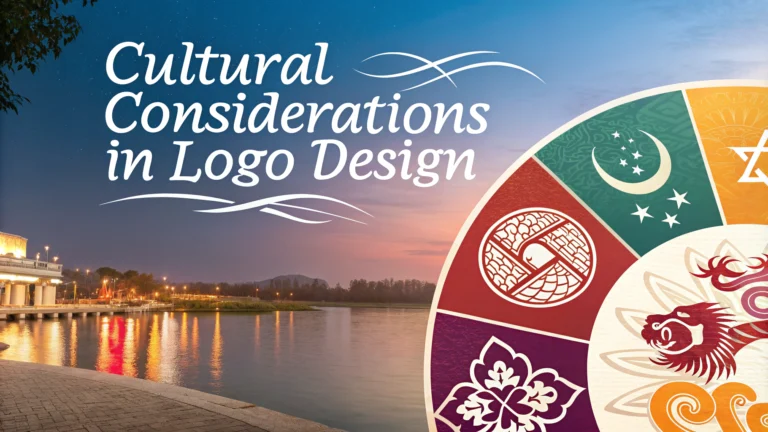Logo design across different cultures requires careful consideration of colors, symbols, and imagery to avoid misinterpretation or offense.
Color Meanings Across Cultures
- Red: Symbolizes luck in China, danger in Western cultures, mourning in South Africa
- White: Represents death in Eastern cultures, purity in Western societies
- Green: Sacred in Islamic cultures, associated with nature in Western countries
- Purple: Signifies royalty in European traditions, mourning in Thailand
Symbol Considerations
Religious symbols, hand gestures, and animals carry different meanings across cultures and should be thoroughly researched before incorporation into logos.
Common Symbol Pitfalls
- Numbers (4 is unlucky in Chinese culture)
- Hand gestures (thumbs up is offensive in some Middle Eastern countries)
- Animals (owls represent death in some Indian cultures)
- Geometric shapes (specific patterns may have religious significance)
Typography and Text Direction
Consider text direction and font choice based on target markets – Arabic reads right to left, while Chinese can be read vertically.
Research Guidelines
- Consult local cultural experts
- Test designs with target market focus groups
- Research historical and religious significance of elements
- Check trademark databases for cultural sensitivity issues
Practical Tips for Cultural Logo Design
- Create flexible logo versions for different markets
- Use culturally neutral symbols when targeting multiple regions
- Document cultural research findings
- Maintain brand consistency while respecting local customs
Professional cultural consultation services can help prevent costly mistakes in international logo design.
Helpful Resources:
- AIGA (American Institute of Graphic Arts): www.aiga.org
- Cross Cultural Design Association: www.ccda.org
- International Council of Design: www.ico-d.org
Market-Specific Adaptations
Successful global brands often create market-specific variations of their logos while maintaining core brand identity elements.
Regional Modifications
- Script adaptations for different writing systems
- Color variations for cultural preferences
- Symbol modifications for local relevance
- Size and proportion adjustments for different applications
Digital Considerations
Modern logo design must account for cross-cultural digital usage and technical requirements across global platforms.
Technical Requirements
- Responsive design for multiple devices
- File format compatibility across regions
- Loading speed optimization for various internet speeds
- Social media platform requirements in different countries
Legal and Trademark Issues
International trademark laws and cultural ownership rights must be considered when designing logos for global markets.
- Regional trademark regulations
- Cultural appropriation concerns
- Indigenous art and symbol usage rights
- Local business naming conventions
Conclusion
Successful cross-cultural logo design requires thorough research, cultural sensitivity, and careful consideration of multiple factors. Designers must balance global brand consistency with local cultural requirements while ensuring technical functionality across different platforms and regions. Professional guidance and continuous market feedback are essential for creating culturally appropriate and effective logo designs that resonate across diverse international markets.
Regular review and updates of cultural design guidelines help maintain relevance and sensitivity in an evolving global marketplace.
FAQs
- How do colors influence logo design across different cultures?
Red signifies luck in Chinese culture but danger in Western cultures, while white represents death in some Asian cultures but purity in Western societies. Understanding these cultural color associations is crucial for global brand success. - What symbols should be avoided in certain cultural contexts?
Hand gestures, religious symbols, and certain animals can be offensive in different cultures. For example, owls symbolize wisdom in Western cultures but death in some Indian cultures, while the thumbs-up gesture is offensive in some Middle Eastern countries. - How does text direction affect logo design in different languages?
Languages like Arabic and Hebrew read right-to-left, requiring logos to be adaptable for these markets. Logos should maintain their integrity and readability when reversed or realigned for different writing systems. - What role does typography play in cross-cultural logo design?
Font choices must consider legibility in multiple languages and cultural associations. Some fonts may appear elegant in Latin script but become illegible or inappropriate when translated into other writing systems. - How do cultural aesthetics influence logo complexity?
Western designs often favor minimalism, while Asian markets may prefer more ornate and detailed logos. Understanding these preferences helps in creating culturally appropriate designs. - What are the considerations for number usage in logos across cultures?
Numbers carry different meanings across cultures. For example, 4 is considered unlucky in Chinese culture, while 8 is lucky. These associations should be considered when incorporating numbers in logo design. - How do cultural holidays and festivals affect logo adaptations?
Many brands modify their logos temporarily for cultural celebrations like Chinese New Year or Ramadan, requiring flexible design systems that can accommodate seasonal variations while maintaining brand recognition. - What role does shape psychology play in different cultures?
Circular shapes might represent harmony in some cultures while square shapes represent stability in others. Understanding these cultural interpretations of shapes is essential for effective logo design. - How should logos adapt to cultural taboos?
Certain imagery may be taboo in specific cultures, such as depicting human figures in some Islamic contexts or specific animals in certain religions. Logos must be designed to avoid cultural offense. - What are the considerations for logo scalability across different writing systems?
Logos must maintain their integrity when adapted for languages with different character heights, spacing, and orientations, such as the vertical text arrangement in traditional Japanese writing.








